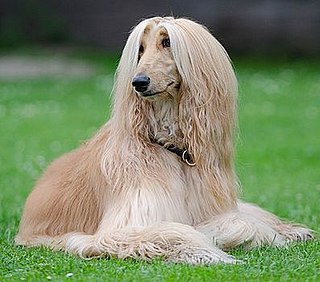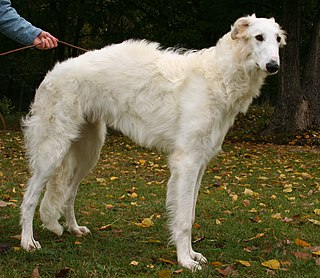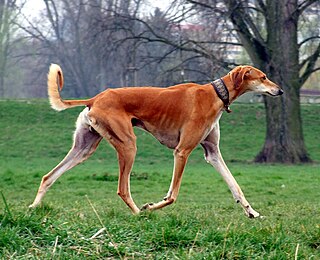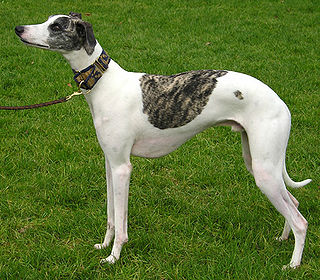
The Afghan Hound is a hound distinguished by its thick, fine, silky coat, and a tail with a ring curl at the end. The breed originates in the cold mountains of Afghanistan. Its local name is Sag-e Tāzī or Tāžī Spay. Other names for this breed are Tāzī, Balkh Hound, Baluchi Hound, and Barakzai Hound.

The Borzoi or Russian Hunting Sighthound is a Russian breed of hunting dog of sighthound type. It was formerly used for wolf hunting, and until 1936 was known as the Russian Wolfhound.

The EnglishGreyhound, or simply the Greyhound, is a breed of dog, a sighthound which has been bred for coursing, greyhound racing and hunting. Since the rise in large-scale adoption of retired racing Greyhounds, the breed has seen a resurgence in popularity as a family pet.

The Ibizan Hound is a lean, agile dog of the hound family. There are two hair types of the breed: smooth and wire. The more commonly seen type is the smooth. Some consider there to be a third type, long, but the longhair is most likely a variation of the wire.

The Saluki is a standardised breed developed from sighthounds – dogs that hunt primarily by sight rather than strong scent – that was once used by nomadic tribes to run down game animals. The dog was originally bred in the Arabian Peninsula. The modern breed is typically deep-chested and long-legged, and similar dogs appear in medieval and ancient art. The breed is most closely related to the Afghan hound, a basal breed that predates the emergence of modern breeds in the 19th century, and the Saluki has been purebred both in the Middle East, including by royalty, since at least that era, and in the West since the 1840s, though as a free-breeding landrace, similar dogs are common as feral animals in the Middle East. A related standardised breed is the north African Sloughi. The saluki is known as one possible explanation for the mythical set animal.

Sighthounds are a type of hound dog that hunts primarily by sight and speed, unlike scent hounds, which rely on scent and endurance.

The Scottish Deerhound, or simply the Deerhound, is a breed of large sighthound, once bred to hunt the red deer by coursing. In outward appearance it is similar to the Greyhound, but larger and more heavily boned, with a rough coat.

The Sloughi, or Arabian Greyhound, is an ancient breed of domesticated dog, specifically a member of the sighthound family. It originates from North Africa and is found in Algeria, Tunisia, Morocco and Libya.

The Shiba Inu is a breed of hunting dog from Japan. A small-to-medium breed, it is the smallest of the six original breed of dogs native to Japan. Its name literally translates to "brushwood dog", as it is used to flush game.

The whippet is a British breed of medium-sized dog, of the sighthound type, related to the larger greyhound and the smaller Italian greyhound. Apart from the differences in height, the whippet closely resembles these two breeds; it has sometimes been described as "the poor man's greyhound". It is kept as a companion dog, for competitive showing, for amateur racing as well as lure coursing. It has the highest running-speed of any breed in its weight and size range, and may have the fastest idle-to-running acceleration of any dog.

A hound is a type of hunting dog used by hunters to track or chase prey.

The Great Dane is a German breed of large mastiff-sighthound, which descends from hunting dogs of the Middle Ages used to hunt bears, wild boar, and deer. They were also used as guardian dogs of German nobility. It is one of the two largest dog breeds in the world, along with the Irish Wolfhound.

Scent hounds are a type of hound that primarily hunts by scent rather than sight. These breeds are hunting dogs and are generally regarded as having some of the most sensitive noses among dogs. Scent hounds specialize in following scent or smells. Most of them tend to have long, drooping ears and large nasal cavities to enhance smell sensitivity. They need to have relatively high endurance to be able to keep track of scent over long distances and rough terrain. It is believed that they were first bred by the Celts by crossbreeding mastiff-type dogs with sighthounds. The first established scent hounds were St. Hubert Hounds bred by monks in Belgium during the Middle Ages.
Lure coursing is a sport for dogs that involves chasing a mechanically operated lure. Competition is typically limited to dogs of purebred sighthound breeds. The AKC has a pass/fail trial for all breeds called the Coursing Ability Test (CAT) and a timed 100 yard dash called Fast CAT where the dog's speed is converted to points.

The Finnish Spitz is a breed of dog originating in Finland. The breed was originally trained to hunt all types of game from squirrels and other rodents to bears. It is a "bark pointer", indicating the position of game by barking, and drawing the game animal's attention to itself, allowing an easier approach for the hunter. Its original game hunting purpose was to point to game that fled into trees, such as grouse, and capercaillies, but it also serves well for hunting elk. Some individuals have even been known to go after a bear. In its native country, the breed is still mostly used as a hunting dog. The breed is typically friendly and good with children, so it is suitable for domestic life. The Finnish Spitz has been the national dog of Finland since 1979.

A lurcher is a crossbred dog resulting from mating a greyhound or other sighthound with a dog of another type such as a herding dog or a terrier. The lurcher is not a "breed," but is a generic descriptor of a group of varying dogs. It was for hundreds of years strongly associated with poaching; in modern times, it is kept as a hunting dog or companion dog.

The Taigan, and also known as Kyrgyz Taighany, Mongolian Taiga dog is a breed of sighthound from Kyrgyzstan. The Taigan is found in the alpine Tian Shan region of Kyrgyzstan on the border with China, it is closely related to the Tazy and the Saluki.
Sanzhar Sultan is a Canadian film director, producer and screenwriter.

Arystanbek Muhamediuly is a Kazakh politician who served as a Minister of Culture and Sports from 11 March 2014 to 17 June 2019. He's currently the director of the National Museum of the Republic of Kazakhstan.
Xigou, also known as Xiquan, Xiliegou, and Chinese Xiquan, is a breed of sighthound native to China. Xigou is a rare dog breed.

















